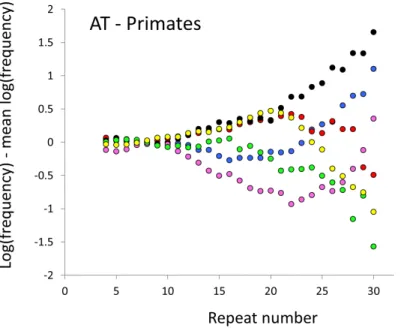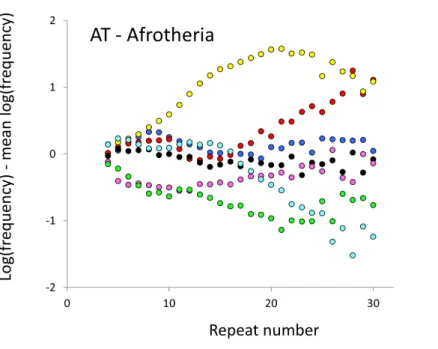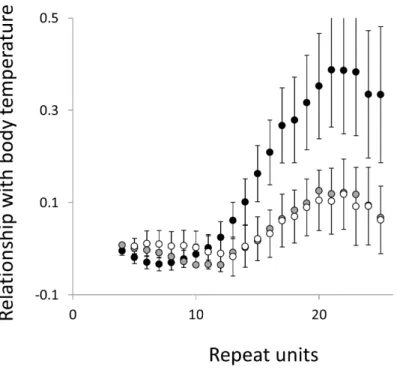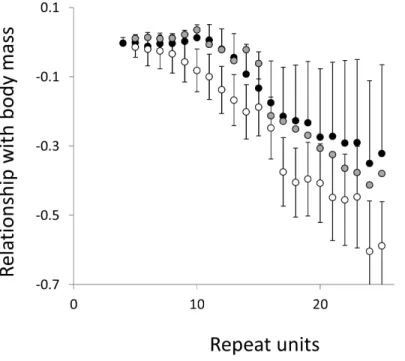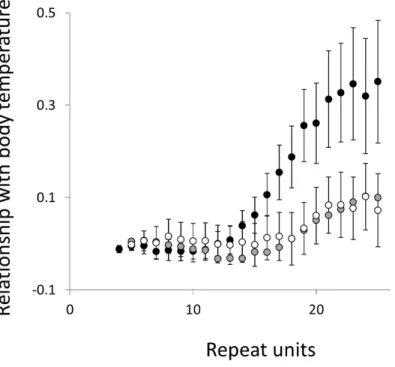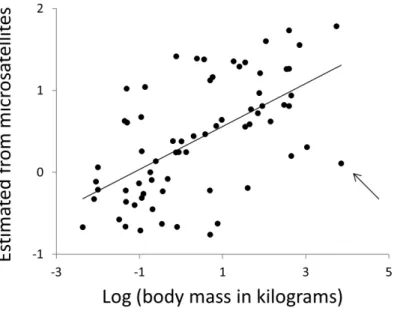Submitted22 June 2014 Accepted 21 October 2014 Published6 November 2014
Corresponding author William Amos, w.amos@zoo.cam.ac.uk
Academic editor Jeffrey Ross-Ibarra
Additional Information and Declarations can be found on page 15
DOI10.7717/peerj.663
Copyright 2014 Amos and Filipe
Distributed under
Creative Commons CC-BY 4.0
OPEN ACCESS
Microsatellite frequencies vary with body
mass and body temperature in mammals,
suggesting correlated variation in
mutation rate
William Amos1and Laura N.S. Filipe2 1Department of Zoology, Cambridge, UK
2Hills Road Sixth Form College, Cambridge, UK
ABSTRACT
Substitution rate is often found to correlate with life history traits such as body mass, a predictor of population size and longevity, and body temperature. The underlying mechanism is unclear but most models invoke either natural selec-tion or factors such as generaselec-tion length that change the number of mutaselec-tion opportunities per unit time. Here we use published genome sequences from 69 mammals to ask whether life history traits impact another form of genetic mutation, the high rates of predominantly neutral slippage in microsatellites. We find that the length-frequency distributions of three common dinucleotide motifs differ greatly between even closely related species. These frequency differences correlate with body mass and body temperature and can be used to predict the phenotype of an unknown species. Importantly, different length microsatellites show complicated patterns of excess and deficit that cannot be explained by a simple model where species with short generation lengths have experienced more mutations. Instead, the patterns probably require changes in mutation rate that impact alleles of different length to different extents. Body temperature plausibly influences mutation rate by modulat-ing the propensity for slippage. Existmodulat-ing hypotheses struggle to account for a link between body mass and mutation rate. However, body mass correlates inversely with population size, which in turn predicts heterozygosity. We suggest that heterozygote instability, HI, the idea that heterozygous sites show increased mutability, could provide a plausible link between body mass and mutation rate.
Subjects Evolutionary Studies, Genetics, Genomics
Keywords Microsatellite, Heterozygosity, Mammal, Evolution, Mutation rate, Phenotype
INTRODUCTION
2010;Bromham, 2011). A good example is body mass in mammals, where larger species evolve more slowly than smaller species (Bromham, Rambaut & Harvey, 1996;Lartillot & Poujol, 2011). The most widely accepted explanation for this involves a link to generation length, but fit to a simple model is poor, in that a doubling of generation time on average results in much less than a halving of evolutionary rate (Welch, Bininda-Emonds & Bromham, 2008).
Despite many studies exploring the relationship between life history traits and evolutionary rate, the overwhelming majority have focused on either mitochondrial DNA or nuclear ‘genes’. Few, if any, have looked explicitly at the fastest evolving components of the genome such as short tandem repeats (STR), yet it is here that the largest effects might be expected. Microsatellites form an important class of STR with repeats one to six nucleotides in length and occur abundantly in higher organisms (Bruford & Wayne, 1993). Most mutations involve molecular slippage causing the gain or loss of repeat units (Schl¨otterer & Tautz, 1992), often with bias favouring contraction or expansion (Dermitzakis et al., 1998;Ellegren, 2000;Xu et al., 2000). Mutation rate increases with repeat number in a strongly non-linear fashion (Weber, 1990;Kelkar et al., 2008). Maximum re-peat number of a given microsatellite motif varies between species (Di Rienzo et al., 1994), probably due to a thermally-influenced upper length boundary (Amos & Clarke, 2008).
Microsatellites seem to be ‘born’ when point mutations by chance create sufficient consecutive repeats for slippage to occur (Messier, Li & Stewart, 1996), persist for a finite time and eventually ‘die’ (Taylor, Durkin & Breden, 1999). The process of death is poorly understood and may well vary between loci, some being deleted while others degenerate through substitutions within the repeat array. However, regardless of the exact details, the relative frequency of any given length of microsatellite in the genome should tend to reflect the relative time spent by an average microsatellite during its lifetime at that length. Short microsatellites are common both because all microsatellites are short at some point and because their low mutation rate causes them to linger at this length. Conversely, long microsatellites are rare both because many loci never become long and because, once a locus becomes long, the much higher mutation rate causes it rapidly either to shrink or to ‘die’. Consequently, the length-frequency distribution of microsatellites in the genome can be viewed as a form of standing wave with microsatellite birth acting as a source and microsatellite death a sink. The exact shape of this wave will reflect a complex interplay between the rates of birth and death and the relationships between repeat number, mutation rate and mutation bias.
two models yield identical predictions in terms of sequence divergence. However, the same does not necessarily hold for microsatellites.
If the system is at or very close to equilibrium the shape of the standing wave will be stable and should not change in response to more or fewer mutations occurring when generation length shortens or lengthens respectively. The shape of the standing wave should only change in response to changes in the parameters that influence its shape, specifically if the relative mutability of different length microsatellites changes or if the relationship between mutation bias and repeat number changes. For example, if longer microsatellites become relatively more mutable, an average microsatellite will spend less time ‘long’, and a new equilibrium wave will be created in which the frequency of long microsatellites is reduced. Such changes should not occur under mutation number models but are a possible (though not necessary) consequence of mutation rate models.
To help understand the relationship between life history traits and mutation rate we used mammalian genome sequences to determine length-frequency profiles for three common microsatellite motifs. We then asked: (a) whether these profiles differ between species and (b) whether any differences relate to two key phenotypes, body temperature or body mass (Gillooly et al., 2005).
MATERIALS AND METHODS
Data
We downloaded 69 complete or largely complete mammalian genomes from the NCBI and UCSC websites (http://www.ncbi.nlm.nih.gov/,http://genome.ucsc.edu/), some as separate assembled chromosomes and others as bulk files of larger, unplaced contigs. Given the different formats, and for complete control, we counted microsatellites using custom C++ scripts written by WA, focusing on three motifs: ‘AC’, ‘AT’ and ‘AG’ (see Fig. S1for annotated example script). Together with their reverses (‘CA’, ‘GA’, ‘TA’), complements (‘TG’, ‘TC’) and their reverse complements (‘GT’, ‘CT’) these embrace all possible dinucleotides with the exception of ‘CG’ and ‘GC’, which are extremely rare due to the high mutability of CpG (Kelkar et al., 2008). In fact, we did also look at (CG) repeats but their general rarity precluded a meaningful analysis: tracts carrying nine or more repeats were absent from at least some species and human(CG)3is 30 fold rarer than
(AT)3. A lower limit of four repeats was set to reflect the shortest length at which slippage is likely important. An upper limit of 30 repeats was set because longer tracts are extremely scarce in some species, probably due to a combination of the known dependence on body temperature and biases arising from differences between sequencing platforms. We also looked at three triplet repeats, ‘ATT’, ‘AGG’ and ‘AAC’. Substitutions within the repeat tract occur at an appreciable rate and act to reduce the rate of slippage (Jin et al., 1996).
Since a minority of tracts are interrupted and interrupted tracts seem to mutate approximately as if they comprise just the longest pure tract (Weber, 1990), we began by counting only pure repeat tracts. No minimum separation was enforced between tracts, such that(AC)10AT(AC)4would count one(AC)10and one(AC)4: the longer tract would
isolated(AC)4tracts. To explore the possible impact of interruption mutations we then repeated the analysis using tracts of the form(XY)aZZ(XY)b, where XY is the target motif,
ZZ represents any pair of bases that is not the target motif. We requiredaandbboth to be greater than one and that either or both were greater than two.
Statistical analysis
All analyses were conducted using R 2.15.2 (http://cran.r-project.org/). To control for shared ancestry, we used the method of phylogenetically independent contrasts (PICs) (Felsenstein, 1985;Purvis & Rambaut, 1995), implemented in the package ‘ape’ (Paradis, Claude & Strimmer, 2004). Calculation of PICs requires a phylogeny with associated branch lengths (Fig. S1). Wherever possible, including all deeper nodes, dates were read from Fig. 1 inMeredith et al. (2011). Dates for other nodes were extracted from individual group phylogenies (Fernandez & Vrba, 2005;Osada et al., 2008;Agnarsson et al., 2011; Perelman et al., 2011;Fabre et al., 2012) (for the resulting phylogeny, seeFig. S2).
To test whether microsatellite frequency differences correlate with life history charac-teristics we focused on two phenotypes, body temperature and sex-averaged adult body mass. Body temperatures vary with factors such as exercise and digestion, and can fall dramatically during hibernation or torpor. We therefore sought values for the ‘normal’ active temperature, and for consistency took as many measurements as possible from one large study byClarke & Rothery (2008)which also gives body masses (Table S1). For four temperatures and one mass we were unable to find reliable values and had to use educated guesses based on closely related species (for details, seeTable S2). For each repeat number (range four to 30) in each of the three dinucleotide motifs (AC, AG, AT) we fitted multiple linear regressions with loge(frequency) as the response and body temperature (◦C), log
10
(body mass, Kg) and %GC content as predictors. %GC content was included to control for the possibility that this influences microsatellite frequencies and has a small but marginally significant impact on the frequencies of the very shortest microsatellites (repeat number
<10). All variables were initially (see below) included as 68 PICs. Once adequate model fit had been achieved, significance was determined using the command ‘anova’ to compare models with and without the term of interest being fitted. Thus, if the full model is written F∼P1+P2+GC (F, log frequency;P1, phenotype1;P2, phenotype 2; GC=%GC); the significance ofP1 would be assessed by comparing the full model with the model F∼P2+GC.
RESULTS
(a) Do closely related species differ in their microsatellite frequencies?
We began by asking whether closely related species exhibit potentially informative differences in their microsatellite frequencies, based on the well-curated genomes of six higher primates (human, chimpanzee, bonobo, gorilla, orang-utan and gibbon). The frequency of any given species—microsatellite length—motif combination,Fijk, was
expressed on a log scale:
Fijk=loge
mijk+1
ni
wheremijkis the raw count of that microsatellite motifk, lengthjin speciesiandniis the
number of nucleotide bases assayed in the genome of speciesi. To create profiles depicting the relative frequencies of each microsatellite in each species across the range of lengths considered (hereafter referred to as ‘profiles’), individual frequencies were expressed as deviations from the mean of all six species (i.e.,Fijk−Fjk). Since higher primates have
rather similar generation lengths (Langergraber et al., 2012) and for general comparison we repeated this analysis on a second group, the Afrotheria, which have an exceptionally wide range of generation lengths, from∼2 years for the Cape elephant shrew up to 25 years for the African elephant (Pacifici et al., 2013).
Figure 1 Variation in relative frequency of different length AC microsatellites in six higher primates.The six higher primates are: human (HAS, black), bonobo (PPA, blue), chimpanzee (PTR, red), gorilla (GGO, pink), orang-utan (PAB, green) and gibbon (NLE, yellow). All frequencies are expressed as natural logarithms and individual data points are then calculated as deviations from the group mean. A value of one thus indicates a frequency 2.7 times the geometric mean of the six species.
Figure 3 Variation in relative frequency of different length AC microsatellites in seven Afrotheria.The seven Afrotheria are: hyrax (PCA, green), tenrec (ETE, black), manatee (TMA, light blue), elephant shrew (EED, pink), golden mole (CAS, blue), elephant (LAF, red) and aardvark (OAF, yellow). All frequencies are expressed as natural logarithms and individual data points are then calculated as deviations from the group mean. A value of one thus indicates a frequency 2.7 times the geometric mean of the seven species.
(b) Do microsatellite frequency differences correlate with pheno-type?
To test for links to life history traits we fitted multiple regressions with phylogenetic correction (see Methods). Associations are summarised as estimates of the slope, to give the size and direction of any relationship, with associated confidence intervals to allow significance to be judged (Figs. 5and6, for raw data seeTable S2, for triplet repeat plots seeFigs. S4andS5). For comparison we also present the same analysis for microsatellites carrying one interruption (Figs. 7and8). The plots for interrupted tracts are generally very similar to those of equivalent pure tracts, presumably because most interrupted tracts derive rather recently from a pure tract of very similar length. Supporting previous observations that microsatellite mutation rate increases with repeat number, trend strength tends to increase with repeat number (Weber, 1990;Kelkar et al., 2008;Sun et al., 2012). A general lack of significant trends among the shortest microsatellites could reflect either the lack of causal link or the mutation rate of short microsatellites, which may be too low to track phenotype evolution in mammals. Note, in interpreting these graphs it is important not to forget the temporal element. The slope estimates are based on PICs and therefore on average tend to reflect how short-term changes in phenotype covary with short-term changes in microsatellite frequency. Over longer periods the observed trends may be different and possibly even reverse.
Figure 6 Relationship between body mass and microsatellite frequency.Three microsatellite motifs were analysed (AT, AC and AG=black, grey and white data series respectively). The vertical axis is the estimate of the slope of the relationship between body mass and logemicrosatellite frequency, corrected for body temperature and the genome’s GC%. All variables are included as phylogenetically independent contrasts. Three data points with high leverage, all corresponding to deeper nodes, were omitted. Error bars are one standard error of the estimate.
Overall significance of the trends is difficult to assess due to the need to control jointly for both 162 multiple tests (=27 lengths×3 motifs×2 phenotypes) and some unknown level of autocorrelation between similar length microsatellites. Nonetheless, there are two reasons to believe the trends are genuine. First, many individual slopes differ significantly either from zero or from each other. Second, the three motifs all show very similarly shaped profiles for each phenotype, while the two phenotypes yield approximately inverse patterns, as indicated by the negative correlation between the slopes for mass and temperature (Figs. S6–S8). Thus, the effect of increasing body temperature tends to be similar to that of decreasing body size and hence increasing population size, consistent with higher mutation rates in larger populations.
(c) Can phenotype be predicted from the frequencies of different length microsatellites?
As indicated, overall significance is difficult to determine due to non-independence. Moreover, the assumption of Brownian evolution that underpins the PIC analysis is unlikely to be met. Consequently, we sought an overall view of the informativeness of these profiles through a form of cross-validation. Each species was assigned to one of 13 major clades, each separated from all other species by at least 50 million years: Artiodactyls
Figure 7 Relationship between body temperature and the frequency in interrupted microsatel-lites.The analysis presented inFig. 5is repeated, but this time using microsatellites carrying a single interruption (for full definition see text).
(n=7); Xenarthra(n=2); Marsupials(n=3); Monotremes(n=1). Note, in view of the unusual ecology of Cetaceans, Cetartiodactyls were divided into the two antiquated constituent groupings.
Body mass and body temperature were then estimated for each species in turn, using simple linear regressions with no phylogenetic correction, based only on data from the 12 other clades. Specifically, multiple regressions were constructed with the phenotype of interest as the response variable with predictor variables microsatellite frequency,F, defined above and the other phenotype. Regressions were fitted for all combinations of repeat type(N =3)and repeat number (range 4–30). Wherever a significant regression (P≤0.01, for other thresholds seeTable S3) was obtained, the R function ‘predict’ was used to obtain an estimate of the response phenotype for the focal taxon. Non-significant regressions were not used since these will largely contribute only noise. Predicted phenotypes were then taken as the average of all individual estimates across all repeat numbers and repeat types. Microsatellite length frequency profiles have significant predictive power for both body temperature (r2=12%,N=68,P=0.004) and body mass (Fig. 9,r2=38%,N=68,P=1.5×10−8,r2rising to 43% if the killer
whale is excluded). Given that estimates of mass vary between databases, particularly for strongly sexually dimorphic species, we tested the robustness of our analysis repeating it twice, each time randomly either doubling or halving each species’ mass. The resulting r-squared values of 41% and 36% indicate that the six orders of magnitude of mass covered by our species range completely dominate any biologically plausible variation in individual species estimates.
DISCUSSION
Here we test the hypothesis that the widely reported link between substitution rate and life history traits extends to neutral, rapidly evolving microsatellites. We find that the frequencies of different length microsatellites vary greatly even between closely related species, and that these differences correlate with both body temperature and body mass. Our results support a link between evolutionary rate and life history traits but the patterns we find are difficult to explain by a simple model where larger species evolve more slowly due to longer generation length.
The complicated patterns of frequency differences seen inFig. 1show that models based on mutation number are inadequate. A key feature of mutation number models is that rank order frequency is expected to be constant (or the inverse) across all motif-length combinations: a species’ rank depending only on the number of generations they have been through since the common ancestor of mammals. Constant rank order is also expected if species differences arise mainly due to differences between sequencing platforms, with some species carrying fewer long microsatellites across all motifs. That rank order varies greatly (54 different orders for the six primates in 81 length-motif combinations) therefore suggests no more than a minor role for generation length and argues against large sequencing platform biases. Similar results are found for the Afrotheria. The relatively minor impact of sequencing platform and assembly state is also indicated by the correlations we find between microsatellite frequency and phenotype. Indeed, since differences due to sequencing platform almost certainly exist and would inflate the error variance, our reported results most likely underestimate the true effect sizes.
Apart from generation length, three other models have been proposed for how mass and substitution rate might be correlated (Bromham, 2011). First, mass might exert an influence through a correlation with metabolic rate and/or body temperature. However, we show an independent effect of body mass in models where body temperature is also fitted. Moreover, body mass and body temperature are only weakly correlated (r2=0.031, n=596, data fromClarke & Rothery (2008)). Second, mutation rate should evolve to increase with a species’ need to gamble (Giraud et al., 2001). Larger species produce fewer, individually costlier offspring so may favour less gambling and therefore lower mutation rates. This explanation fails because microsatellites are mostly neutral and evolve primarily through slippage (Schl¨otterer & Tautz, 1992), so microsatellites are unlikely to be affected by evolved changes in substitution rate, should these exist and evolve at a high enough rate in higher vertebrates. Microsatellite mutation rates might vary rapidly through evolved changes in the mismatch repair system, particularly if a selfish evolutionary arms race were involved. However, this model fails through lack of any plausible link to phenotype: selfish processes tend to be ‘blind’.
the exact opposite of what has been observed (Amos, 2011). Our current data agree: in Fig. 2the slopes for the two phenotypes are generally negatively correlated (Fig. S3), suggesting that an increase in body temperature (=more slippage) has a similar impact to a decrease in body size. There is also the recurrent problem with models that invoke selection that, while some microsatellites occur in functional regions and may be selected (The Huntington’s Disease Collaborative Research Group, 1993), most are likely neutral (Buschiazzo & Gemmell, 2010) or effectively so.
One model not previously considered for how microsatellite frequencies and body mass might become correlated is heterozygote instability (HI). The HI hypothesis proposes that recognition and ‘repair’ of heterozygous sites during meiosis leads to additional rounds of DNA replication that in turn provide opportunities for extra mutations (Amos, 2010b). HI predicts that mutation rate should scale with population size and hence with body mass due to the classical positive relationship between heterozygosity and population size (Hartl, 1988;Slatkin, 1995). Evidence for HI comes variously from the way SNPs are clustered, which fits well with a model where new mutations occur preferentially near pre-existing polymorphisms (Drake, 2007;Amos, 2010a;Schrider, Hourmozdi & Hahn, 2011), from the reduction in mutation rate that occurred as humans lost variability leaving Africa (Amos, 2013) and, most directly, from the correlation between microsatellite mutation rate and modern human population size (Amos, 2011). Direct mutation counting gives conflicting results, two studies providing support for HI (Amos et al., 1996;Masters et al., 2011) but another not (Sun et al., 2012), though the latter appears not to control for the greater detectability of mutations in homozygotes.
While HI remains an unproven hypothesis, it has the potential to explain some aspects of our results that cannot be accommodated easily by existing models. First, HI acts directly on mutation rate rather than mutation number, so could change the shape of a microsatellite length-frequency profile. Second, HI can explain mutation rate differences between morphologically and physiologically similar relatives such as chimpanzees and bonobos, as long as they differ in their demographic histories. Third, HI can account for links to life history traits for both base substitutions (Amos, 2013) and slippage in microsatellites (Amos, 2011), and operates independently of natural selection. Finally, the impact of body mass is consistent with predictions from HI because, as discussed above, higher rates of slippage seem linked to greater population size (=smaller mass). Despite this, HI does not offer a complete explanation because it cannot account for links between life history traits and haploid regions of the genome such as mitochondrial DNA (Samuels, 2004;Khaidakov, Siegel & Shmookler Reis, 2006;Welch, Bininda-Emonds & Bromham, 2008; Nabholz, Gl´emin & Galtier, 2009).
method that focuses on trait changes relative to a (usually recent) common ancestor. By comparison, body mass tends to be much more stable, varying much more between than within major clades and most trends are towards larger body size (Alroy, 1998). For mass, therefore, independent contrasts often embrace rather little change and tend to be relatively uninformative, while regressions across all taxa cover a wide range of sizes and are robust enough to give excellent predictability.
Mutation bias seems an integral feature of microsatellite evolution (Primmer et al., 1996;Sun et al., 2012) and may obey complicated rules (Ellegren, 2000;Xu et al., 2000). Our results also support the existence of biases. Without bias, the shape of the allele length-frequency profile will be stable because the average change in length of an allele over time is zero, regardless of variation in either mutation rate or mutation number. Profile shape changes require the joint action of mutation bias, to create asymmetry, and a change to the relative mutability of different length alleles. For example, suppose short microsatellites tend to expand under an upward mutation bias (Xu et al., 2000) and that a change to the mutation process either creates more short microsatellites or increases their relative mutability. The result would be a pulse of excess frequency that would migrate upwards in length until lost at the upper boundary. Such a model is speculative, and more modelling is needed to establish its viability, but it seems intuitively in keeping with the patterns seen inFigs. 1–4.
The ability to predict a species’ body mass to about an order of magnitude may appear unremarkable but we argue that this predictability can be seen as surprisingly good. First, mass is unlikely to influence microsatellite frequencies directly but instead must act through a (likely weak) correlation with some other factor such as population size. Second, even the high mutation rates of microsatellites are unlikely to prevent appreciable lag between the shape of the length-frequency distribution and changes to phenotype. Third, we consider only two factors in our prediction model, body mass and body temperature. If other factors are important, their omission will degrade predictive power. All these elements will inflate the error variance and suggest that more detailed modelling could allow an appreciable increase in predictability.
ADDITIONAL INFORMATION AND DECLARATIONS
Funding
The authors declare there was no funding for this work.
Competing Interests
William Amos is an Academic Editor for PeerJ.
Author Contributions
• William Amos conceived and designed the experiments, performed the experiments, analyzed the data, contributed reagents/materials/analysis tools, wrote the paper, prepared figures and/or tables, reviewed drafts of the paper.
• Laura N.S. Filipe performed the experiments, wrote the paper, reviewed drafts of the paper.
Supplemental Information
Supplemental information for this article can be found online athttp://dx.doi.org/ 10.7717/peerj.663#supplemental-information.
REFERENCES
Agnarsson I, Zambrana-Torrelio CM, Flores-Saldana NP, May-Collado LJ. 2011. A time-calibrated species-level phylogeny of bats (Chiroptera, Mammalia).PLoS Currents 3:RRN1212–RRN1212DOI 10.1371/currents.RRN1212.
Alroy J. 1998.Cope’s rule and the dynamics of body mass evolution in North American fossil mammals.Science280:731–734DOI 10.1126/science.280.5364.731.
Amos W. 2010a.Even small SNP clusters are non-randomly distributed: is this evidence of mutational non-independence?Proceedings of the Royal Society B277:1443–1449
DOI 10.1098/rspb.2009.1757.
Amos W. 2010b.Heterozygosity and mutation rate: evidence for an interaction and its implications.BioEssays32:82–90DOI 10.1002/bies.200900108.
Amos W. 2011.Population-specific links between heterozygosity and the rate of human microsatellite evolution.Journal of Molecular Evolution72:215–221
DOI 10.1007/s00239-010-9423-2.
Amos W. 2013.Variation in heterozygosity predicts variation in human substitution rates between populations, individuals and genomic regions.PLoS ONE8:e63048
DOI 10.1371/journal.pone.0063048.
Amos W, Clarke A. 2008.Body temperature predicts maximum microsatellite length in mammals.
Biology Letters4:399–401DOI 10.1098/rsbl.2008.0209.
Amos W, Sawcer SJ, Feakes R, Rubinsztein DC. 1996.Microsatellites show mutational bias and heterozygote instability.Nature Genetics13:390–391DOI 10.1038/ng0896-390.
Bromham L. 2011.The genome as a life-history character: why rate of molecular evolution varies between species.Philosophical Transactions of the Royal Society of London366:2503–2513
Bromham L, Rambaut A, Harvey PH. 1996.Determinants of rate variation in mammalian DNA sequence evolution.Journal of Molecular Evolution45:610–621DOI 10.1007/BF02202109.
Bruford MW, Wayne RK. 1993.Microsatellites and their application to population genetic studies.
Current Opinion in Genetics and Development3:939–943DOI 10.1016/0959-437X(93)90017-J.
Buschiazzo E, Gemmell NJ. 2010.Conservation of human microsatellites across 450 million years of evolution.Genome Biology and Evolution2:153–156DOI 10.1093/gbe/evq007.
Clarke A, Rothery P. 2008.Scaling of body temperature in mammals and birds.Functional Ecology 22:58–67DOI 10.1111/j.1365-2435.2007.01341.x.
Damuth J. 1981.Population density and body size in mammals. Nature290:699–700
DOI 10.1038/290699a0.
Dermitzakis ET, Clark AG, Batargias C, Magoulas A, Zouros E. 1998.Negative covariance suggests mutation bias in a two-locus microsatellite system in the fishSparus aurata.Genetics 150:1567–1575.
Di Rienzo A, Peterson AC, Garza JC, Valdes AM, Slatkin M. 1994.Mutational processes of simple sequence repeat loci in human populations.Proceedings of the National Academy of Sciences of the United States of America91:3166–3170DOI 10.1073/pnas.91.8.3166.
Drake JW. 2007.Too many mutants with multiple mutations.Critical Reviews in Biochemistry and
Molecular Biology42:247–258DOI 10.1080/10409230701495631.
Ellegren H. 2000.Heterogeneous mutation processes in human microsatellites.Nature Genetics 24:400–402DOI 10.1038/74249.
Fabre P-H, Hautier L, Dimitrov D, Douzery EJP. 2012. A glimpse on the pattern of rodent diversification: a phylogenetic approach.BMC Evolutionary Biology12:Article 88
DOI 10.1186/1471-2148-12-88.
Felsenstein J. 1985.Phylogenies and the comparative method.American Naturalist125:1–15
DOI 10.1086/284325.
Fernandez MH, Vrba ES. 2005.A complete estimate of the phylogenetic relationships in Ruminantia: a dated species-level supertree of the extant ruminants.Biological Reviews 80:269–302DOI 10.1017/S1464793104006670.
Fitch WM. 1983.Does the molecular clock keep time?Heredity50:213.
Gillooly JF, Allen AP, West GB, Brown JH. 2005.The rate of DNA evolution: effects of body size and temperature on the molecular clock.Proceedings of the National Academy of Sciences of the
United States of America102:140–145DOI 10.1073/pnas.0407735101.
Giraud M, Matic I, Tenaillon O, Radman M, Fons M, Taddei F. 2001.Costs and benefits of high mutation rates: adaptive evolution of bacteria in the mouse gut.Science291:2606–2608
DOI 10.1126/science.1056421.
Hartl DL. 1988.A primer of population genetics. Sunderland, Massachusetts: Sinauer.
Jin L, Macaubas C, Hallmayer J, Kimura A, Mignot E. 1996.Mutation rate varies among alleles at a microsatellite locus: phylogenetic evidence.Proceedings of the National Academy of Sciences of the United States of America93:15285–15288DOI 10.1073/pnas.93.26.15285.
Kelkar YD, Tyekucheva S, Chlaromonte F, Makova K. 2008.The genome-wide determinants of human and chimpanzee microsatellite evolution. Genome Research 18:30–38
DOI 10.1101/gr.7113408.
Khaidakov M, Siegel ER, Shmookler Reis RJ. 2006. Direct repeats in mitochondrial DNA and mammalian lifespan. Mechanisms of Ageing and Development 127:808–812
Lanfaer R, Welch JJ, Bromham L. 2010.Watching the clock: studying Watching the clock: studying variation in rates of molecular evolution between species.Trends in Ecology and Evolution 25:495–503DOI 10.1016/j.tree.2010.06.007.
Langergraber KE, Pruefer K, Rowney C, Boesch C, Crockford C, Fawcett K, Inoue E, Inoue-Muruyama M, Mitani JC, Muller MN, Robbins MM, Schubert G, Stoinski TS, Viola B, Watts D, Wittig RM, Wrangham RW, Zuberbuehler K, Paeaebo S, Vigilant L. 2012.
Generation times in wild chimpanzees and gorillas suggest earlier divergence times in great ape and human evolution.Proceedings of the National Academy of Sciences of the United States of
America109:15716–15721DOI 10.1073/pnas.1211740109.
Lartillot N, Poujol R. 2011.A phylogenetic model for investigating correlated evolution of substitution rates and continuous phenotypic characters.Molecular Biology and Evolution 28:729–744DOI 10.1093/molbev/msq244.
Margoliash E. 1963.Primary structure and evolution of cytochrome C.Proceedings of the National Academy of Sciences of the United States of America50:672–679DOI 10.1073/pnas.50.4.672.
Martin AP, Palumbi SR. 1993.Body size, metabolic rate, generation time, and the molecular clock.
Proceedings of the National Academy of Sciences of the United States of America90:4087–4091
DOI 10.1073/pnas.90.9.4087.
Masters BS, Johnson LS, Johnson BGP, Brubaker JL, Sakaluk SK, Thompson CF. 2011.Evidence for heterozygote instability in microsatellite loci in house wrens.Biology Letters7:127–130
DOI 10.1098/rsbl.2010.0643.
Meredith RW, Janecka JE, Gatesy J, Ryder OA, Fisher CA, Teeling EC, Goodbla A, Eizirik E, Simao TLL, Stadler T, Rabosky DL, Honeycutt RL, Flynn JJ, Ingram CM, Steiner C, Williams TL, Robinson TJ, Burk-Herrick A, Westerman M, Ayoub NA, Springer MS, Murphy WJ. 2011.Impacts of the cretaceous terrestrial revolution and KPg extinction on mammal diversification.Science334:521–524DOI 10.1126/science.1211028.
Messier W, Li S-H, Stewart C-B. 1996. The birth of microsatellites. Nature 381:483DOI 10.1038/381483a0.
Nabholz B, Gl´emin S, Galtier N. 2009.The erratic mitochondrial clock: variations in mutation rate, not population size, affect mtDNA diversity across birds and mammals.BMC Evolutionary Biology9:54DOI 10.1186/1471-2148-9-54.
Ohta T. 1987.Very slightly deleterious mutations and the molecular clock.Journal of Molecular
Evolution26:1–6DOI 10.1007/BF02111276.
Osada N, Hashimoto K, Kameoka Y, Hirata M, Tanuma R, Uno Y, Inoue I, Hida M, Suzuki Y, Sugano S, Terao K, Kusuda J, Takahashi I. 2008.Large-scale analysis of Macaca fascicularis transcripts and inference of genetic divergence between M-fascicularis and M-mulatta.BMC Genomics9:Article 90DOI 10.1186/1471-2164-9-90.
Pacifici M, Santini L, Di Marco M, Baisero D, Francucci L, Marasini GG, Visconti P, Rondinini C. 2013.Generation length for mammals.Nature Conservation 5:89–94
DOI 10.3897/natureconservation.5.5734.
Paradis E, Claude J, Strimmer K. 2004.APE: analysis of phylogenetics and evolution in R language.Bioinformatics20:289–290DOI 10.1093/bioinformatics/btg412.
Perelman P, Johnson WE, Roos C, Seuanez HN, Horvath JE, Moreira MAM, Kessing B,
Pontius J, Roelke M, Rumpler Y, Schneider MPC, Silva A, O’Brien SJ, Pecon-Slattery J. 2011.
A molecular phylogeny of living primates.PLoS Genetics7:e1001342
Primmer C, Ellegren H, Saino N, Møller AP. 1996.Directional evolution in germline microsatellite mutations.Nature Genetics13:391–393DOI 10.1038/ng0896-391.
Purvis A, Rambaut A. 1995.Comparative analysis by independent contrasts (CAIC): an Apple Macintosh application for analysing comparative data.Computer Applications in the Biosciences 11:247–251DOI 10.1093/bioinformatics/11.3.247.
Samuels DC. 2004.Mitochondrial DNA repeats constrain the life span of mammals.Trends in Genetics20:226–229DOI 10.1016/j.tig.2004.03.003.
Schl¨otterer C, Tautz D. 1992.Slippage synthesis of simple sequence DNA.Nucleic Acids Research 20:211–215DOI 10.1093/nar/20.2.211.
Schrider DR, Hourmozdi JN, Hahn MW. 2011.Pervasive multinucleotide mutation events in eukaryotes.Current Biology21:1051–1054DOI 10.1016/j.cub.2011.05.013.
Slatkin M. 1995.A measure of population subdivision based on microsatellite allele frequencies.
Genetics139:457–462.
Smith SA, Donoghue MJ. 2008.Rates of molecular evolution are linked to life history in flowering plants.Science322:86–89DOI 10.1126/science.1163197.
Sun JX, Helgason A, Masson G, Ebenesersdottir SS, Li H, Mallick S, Gnerre S, Patterson N, Kong A, Reich D, Stefansson K. 2012.A direct characterization of human mutation based on microsatellites.Nature Genetics44:1161–1165DOI 10.1038/ng.2398.
Taylor JS, Durkin MH, Breden F. 1999. The death of a microsatellite: a phylogenetic perspective on microsatellite interruptions.Molecular Biology and Evolution16:567–572
DOI 10.1093/oxfordjournals.molbev.a026138.
The Huntington’s Disease Collaborative Research Group. 1993.A novel gene containing a trinucleotide repeat that is expanded and unstable on Huntington’s disease chromosomes.
Cell72:971–983DOI 10.1016/0092-8674(93)90585-E.
Tuntiwechapikul W, Satazar M. 2002.Mechanism ofin vitroexpansion of long DNA repeats: effect of temperature, repeat length, repeat sequence and DNA polymerases.Biochemistry 41:854–860DOI 10.1021/bi0110950.
Weber JL. 1990.Informativeness of human (dC-dA)n (dG-dT)n polymorphisms.Genomics 7:524–530DOI 10.1016/0888-7543(90)90195-Z.
Welch JJ, Bininda-Emonds ORP, Bromham L. 2008.Correlates of substitution rate variation in mammalian protein-coding sequences.BMC Evolutionary Biology8:53
DOI 10.1186/1471-2148-8-53.
Xu X, Peng M, Fang Z, Xu X. 2000.The direction of microsatellite mutations is dependent upon allele length.Nature Genetics24:396–399DOI 10.1038/74238.
